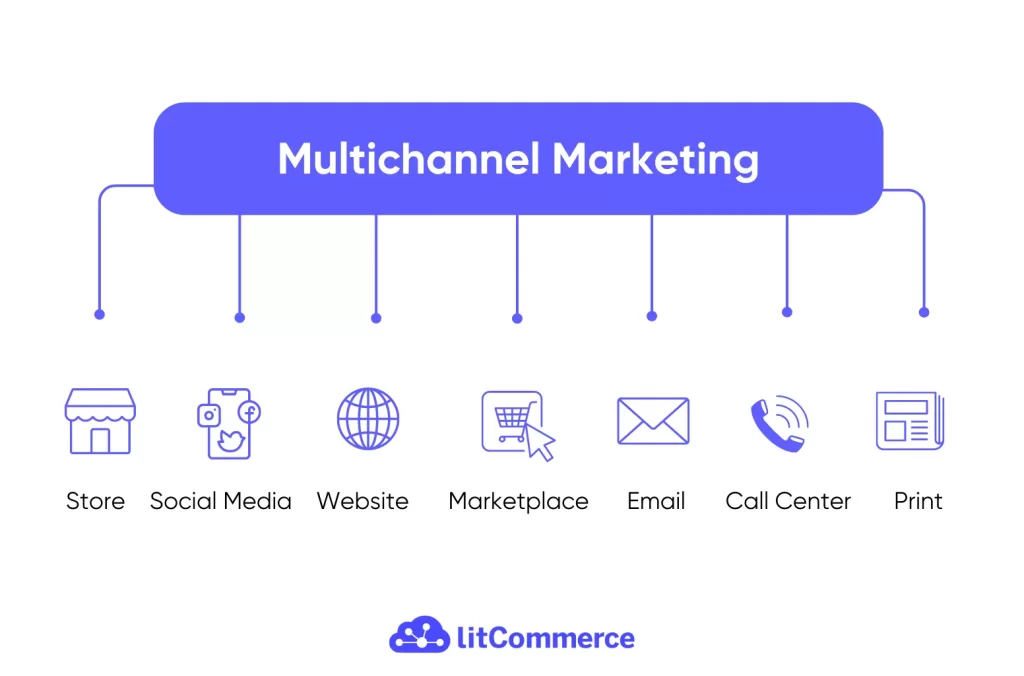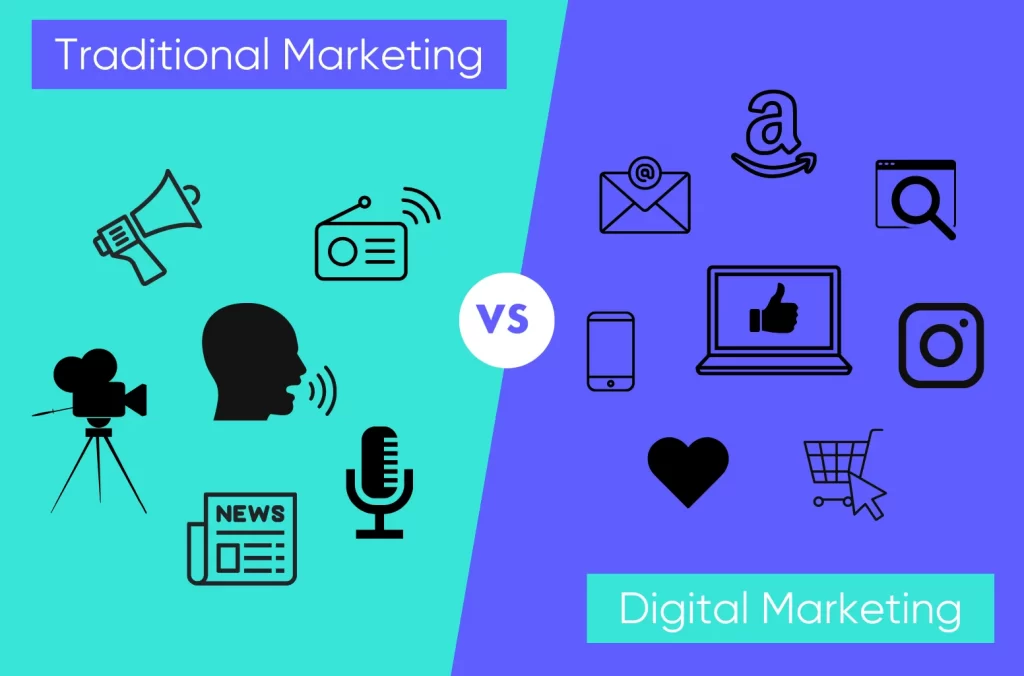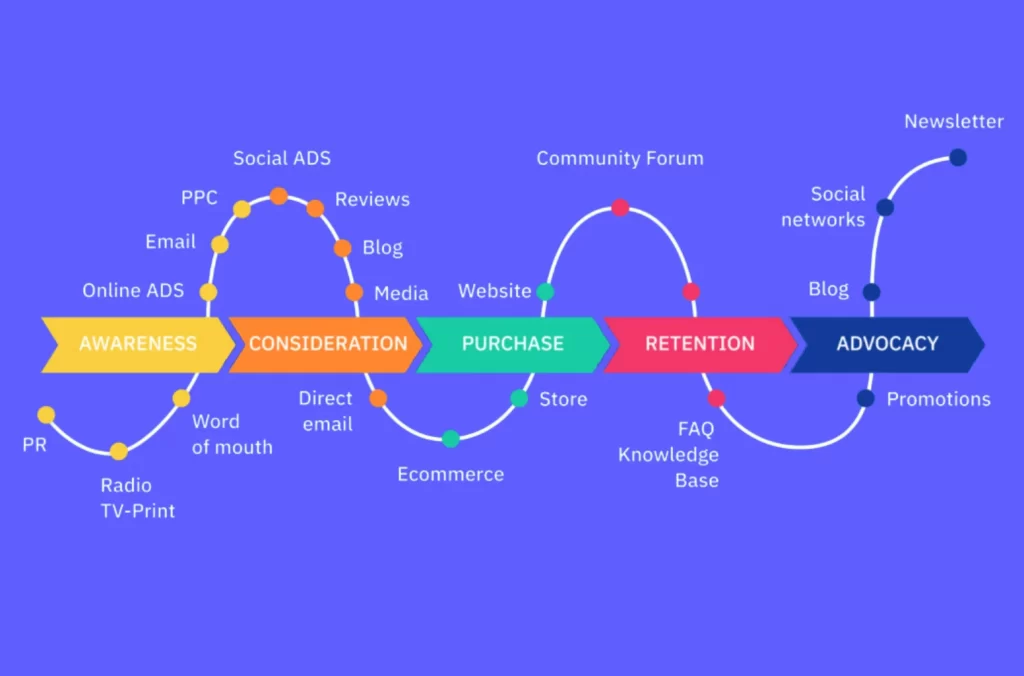With the evolution of technology, came the evolution of marketing offering new channels to promote your brand. Digital channels like email, social media, and online marketplaces have completely transformed the marketing landscape. Nowadays, relying on solely a brick-and-mortar store seems old-fashioned and ineffective. As a result, many companies have begun employing multichannel marketing strategies to reach more customers.
In this article, we will discover what multichannel marketing is and then explore how to create winning multichannel marketing strategies with the following steps:
- #1. Understand your buyer persona
- #2. Choose the right channels
- #3. Map out your customer journey
- #4. Tailor your message to each channel
- #5. Integrate experience across channels
- #6. Measure multichannel campaign performance
What is Multichannel Marketing?
First thing first, let’s begin with the multichannel marketing definition.
Multichannel marketing refers to the use of several different channels to spread marketing messages and communicate with customers. These channels might include the web store, physical store, email, social media, marketplace, television, radio, paid media advertising, display ads, text messages, and more. By implementing multichannel marketing in your multichannel selling journey, your business can leverage the unique strengths of each channel and reach more customers.

Benefits of multichannel marketing
Many studies show that multichannel marketing is more effective and then it has become one of the successful eCommerce strategies of a lot of brands over decades. So, why multichannel marketing is worth it?
#1. Expand reach
First of all, implementing multichannel marketing strategies helps brands reach as much as customers as they can. Customer behaviors have changed dramatically over the past few decades due to the rise of online platforms. Nowadays, customers are active on more channels than ever, navigating from social media such as Instagram, and TikTok, to the best online selling platforms like Shopify, Amazon, or eBay.
Therefore, if you only use a single channel to promote your brand, you are likely to limit your reachability to potential customers. In contrast, by being present on a range of channels, brands can connect to customers with different behaviors, whenever or wherever they are.
#2. Varify potential customer touchpoints
Besides increasing reach, the availability of different channels enables businesses to meet potential customers at the right time and right place, leading to meaningful touchpoints. Using multichannel strategies, you also can avoid spamming your customers with a bunch of messages all day long on the same channel.
For example, brands create fun or valuable content to engage customers in the awareness stage, while using email marketing to retarget their customers in the consideration stage. Let’s say a customer visits an online store and adds a few items to their shopping cart but leaves without making a purchase. In this case, the brand can send an automated follow-up email to remind them of the items left in the cart and offer a special discount or promotion to entice them to return and make the purchase.
#3. Offer preferred channels for customers
Last but not least, multichannel marketing strategies allow customers to make a purchase directly on their preferred channel, leading to higher satisfaction and conversion rates.
Let’s take an example of the clothing brand Zara. The brick-and-mortar stores of this brand cater to customers who prefer trying on outfits and hands-on experience. Meanwhile, Zara’s online store serves customers who love going shopping in a fast and convenient way, right from their homes.
Challenges of multichannel marketing
Although multichannel marketing offers many benefits when creating multi-channel campaigns, your team needs to face off and deal with some challenges below.
#1. More channels, more management
It’s obvious that multi-channel marketing comes with more tasks than single-channel marketing. Running multi-channel marketing strategies often requires more resources, including manpower and time to effectively manage and optimize campaigns on multiple platforms. In other words, you may even need more team members for each channel. Therefore, allocating resources appropriately can be a challenge, especially for smaller businesses with limited resources.
Furthermore, managing data from various channels can be complex and time-consuming. Different platforms may use different formats and structures, making it difficult to obtain a unified view of data.
#2. Multi-channel marketing can be costly
From the financial aspect, multiple platforms require a larger monetary investment as you craft strategy, produce content, and pay for sponsored ads placement. So, balancing the costs and returns is crucial to ensure that the investment in multi-channel marketing yields profitable results for the business.
How to Create Successful Multichannel Marketing Strategies?
We now understand what multichannel marketing is, how it works, its benefits, and common challenges. Let’s reveal the secrets of how to create winning multichannel marketing strategies.
Don’t forget that a multichannel marketing strategy is a marketing strategy. When implementing it, we need to follow all the basic foundations of marketing.
#1. Understand your buyer persona
When planning multichannel marketing strategies, you have to define clearly who your target customer is. How old are they? What do they do in life? How much do they make a year? Which topic do they care about? And which problems does your business help them to solve?
By answering these questions, you will have a detailed buyer persona. The characteristics such as demographic (age, education, occupation, and income), and psychographics (habits, beliefs, behaviors, and preferences) will help you choose which are focused channels and which kind of tone to use or message to spread.
Marketing is divided into B2B and B2C. Implementing the B2B marketing strategy, your audience might be the team member of a business, they might be sales or marketing team members. On the other hand, the target audience of B2C marketing is usually the individual.
#2. Choose the right channels
Now, let’s move to the “Place” element in the classic marketing model 4Ps.
Once you have identified your customer persona, you will need to define which channels your brand will reach them or which platforms to show your products. Your website is one channel but multichannel marketing includes multiple channels. Some channels might work for your brand, others might not.
For example, a fashion brand targeting young and trendy consumers might find success by utilizing social media channels like Instagram and TikTok. At the same time, this brand can open a store on Amazon, and optimize their product listings for better visibility. Meanwhile, a B2B software company that targets corporate clients may find value in channels like LinkedIn or through search engine optimization (SEO).

The marketing channels can be divided into 2 broad types: traditional and digital. The traditional channel comprises physical stores, print media, television, press, etc. On the other hand, digital channels include the platforms used on computers or mobile devices such as social media, email, web, and eCommerce platforms. Nowadays, digital channels seem to be favored for their wide reach and precise targeting. However, even when you opt only for digital channels, go into detail about which ones work for your business.
Moreover, marketing channels also can be divided into direct and indirect. Direct channels refer to the ones where a brand can sell directly their product or service to customers. Meanwhile, indirect distribution channels are third-party sellers or intermediaries. These multichannel selling activities are especially important in the retail industry.
To sum up, whether your business uses digital, traditional, direct or indirect channels, or even a combination of them, be where your customers are. Being on the channels where your brand can meet your buyer persona is the key to an effective multi-channel marketing strategy.
#3. Map out your customer journey
Mapping out the customer journey is another crucial step in multichannel marketing. It allows businesses to identify how they use each channel to interact with their potential customers in each buying stage. For instance, your team can write blog posts that suggest several solutions for a problem of your customer in the awareness stage.
By identifying touchpoints and pain points of each buying stage, businesses can optimize their activities on each channel. Reaching your customers at the right time and on the right channels can increase customer satisfaction and overall marketing effectiveness.

#4. Follow the rules of each channel
Finishing choosing the marketing channels for different stages of your customer journey, you have taken one step closer to winning multichannel marketing strategies. The next step? Whatever you do, email marketing, social media marketing, or search engine marketing, tailor your activities to each channel.
For instance, successful email marketing might require appealing titles while social media marketing on TikTok and Instagram may see more success with images, music, and videos. Besides, the way that you optimize the keywords on the top marketplaces also differs from the way you do with your blog posts. Another example? Pay-per-click advertising for sponsored search engine results has different criteria in comparison with sponsored posts on Facebook.
For that reason, your need to create individual strategies for each channel and various types of content and advertising.
#5. Integrate experience across channels
Tailoring strategies that fit multiple channels is great. However, integrating experience across channels is likely to take your multichannel marketing strategies to the next level.
Customers often switch from one channel to another during their journey with your brand. To leave a lasting impression and drive purchases, it’s crucial to maintain message consistency and provide a seamless experience across all channels. When your brand presents a cohesive identity, customers are more likely to remember and trust it. On the other hand, a disjointed experience may jar or confuse your audience, leading to missed opportunities for conversion.
Integrating multiple channels seems to be a daunting task. That’s why multichannel marketing solutions companies like customer relationship management (CRM) tools come. They help you track interactions and engagement with customers, and automate your activities across different channels. They can be extra handy in niche businesses. For instance, in case of a real estate category, a CRM for real estate will store and manage all customer-related information in one place.
If you are selling on multiple channels, marketplace integration comes with a lot of hassle as well. A multichannel tool like LitCommerce helps you to manage the product listing on multiple channels, simplifying your multichannel selling journey.
#6. Measure multichannel campaign performance
To have effective multichannel marketing strategies, it is crucial for a company to measure the performance of the completed campaign. This evaluation enables businesses to measure the effectiveness of their effort and identify which campaigns on which channels contributed the most to hot leads.
By analyzing regularly your performance, you also can make data-driven decisions about the channels that your company should continue to invest in or build your own multi-channel marketing system to maximize your marketing effectiveness.
Examples of Winning Multichannel Marketing Strategies
You might still wonder which brands implement multichannel marketing strategies or how they launch multichannel marketing. Here are some multichannel marketing strategies to inspire you.
Apple – The giant American technology company
Apple is a prime example of a company that excels in multichannel marketing. This brand can be seen as a “click-and-mortar” retailer as they combine both traditional and digital channels to reach their diverse customer base worldwide.
Until June 2023, Apple has expanded the number of physical stores to 526 stores across 26 countries and regions worldwide. Although most of Apple’s sales come through eCommerce, this tech giant still opens physical stores and uses them as touchpoints that allow customers to visit and experience new products or shop for accessories, which enhances the overall Apple experience.
Besides the brick-and-mortar stores, this company also lists a wide range of Macs, Ipad, and iPhones, and sells them directly on its clean-designed web store. When customers buy online, Apple even lets them “Get the Apple products you want, the way you want“. The customer can choose to get delivery or in-store pick-up. This multichannel combination also contributes to creating a seamless customer experience across different channels.

Regarding the digital platforms, in addition to the website, brands have leveraged many popular social media platforms like TikTok, Instagram, Twitter, and YouTube to connect with their audience in a more close way, or email to stay in touch with them. Apple is no exception. This brand employs email marketing to keep customers informed about product launches, promotions, and software updates. When implementing the social media marketing strategy, Apple uses its over-30-million-follower Instagram account to post high-quality and aesthetic pictures, which might showcase new products or highlight their key features.
Even though Apple puts a lot of effort into its direct channels, they still leverage the power of third-party sellers. Consumers can purchase Apple products from third-party sellers and carrier providers, such as stores like BestBuy, Walmart, and Target. These indirect channels offer easy accessibility and may provide discounts, making Apple products more accessible to a broader customer base.
Overall, the success story of Apple results from many elements, not only a high-performing marketing strategy. However, when it comes to marketing, Apple has implemented multichannel marketing strategies for years. Their multichannel marketing strategies follow strict and specific brand guidelines. This consistency has contributed to building an easily recognizable brand. Besides, Apple has diversified its marketing channels to create more touchpoints with customers with different preferences and behaviors.
Home Depot – A home improvement retail corporation
Home Depot is another multichannel marketing example done right. They used to mainly rely on their in-store expertise. But they’ve put more effort into expanding the marketing and selling channels and improving the buying experience for their customers. Over the past several years, Home Depot has invested nearly $300 million into upgrading its eCommerce offering – combining its physical with online stores and inventory.
In 2014, the investment began to seriously pay off, to the tune of $3.5 billion in online sales, increasing by $1 billion from the year prior. How they made it? Home Depot offers a buy-online in-store pickup option. About 40% of their orders involve this multichannel combining method, allowing this brand to leverage their existing physical assets.

But it’s not just about selling. If you visit their website, you’ll find lots of blog posts showing off DIY projects you can do yourself at home. Home Depot implement the content marketing strategy and build their potential customer base on their knowledge and expertise. This smart approach doesn’t just get customers excited about trying new things, it also brings in more revenue as customers buy the tools and products they need.
And there’s more – Home Depot knows how to send emails that people actually like. They send messages tailored to what customers have bought before and what they’ve been checking out on their app and website.
Whether customers are online or in the store, Home Depot makes their shopping easier and more enjoyable by mixing old-school strengths with new digital tricks. They also have gained customer trust by creating valuable and educational content and personalizing their emails.
By implementing the multichannel marketing strategies effectively as well as other selling activities, over the past few years, Home Depot has increased continuously their revenue, even in 2020, and 2021- when the coronavirus pandemic has devasted much of the retail industry. Last year, in 2022, Home Depot’s annual revenue hit $151.1 billion.
Multichannel Marketing Strategies – FAQs
- What is a multichannel marketing strategy?
The multichannel marketing strategy refers to marketing activities that involve multiple channels to reach and engage with potential customers. They might be email, social media, print, mobile apps, display ads, television, and more. Implementing multichannel marketing strategies allows brands to have more touch points with their customers, wherever they are.
- What is an example of multichannel marketing?
Multichannel marketing is now implemented by a lot of brands from SMEs to big brands. Let’s take the example of CVS. This brand has combined print advertising with digital email communications for its multichannel marketing strategy.
- Why have many companies begun employing multichannel marketing strategies?
The new technology has changed the marketing landscape and the customer behavior. Moreover, multichannel marketing has become more effective than single-channel marketing. That’s what has led to the increased attention on multichannel marketing.
- What are the 3 keys to success for multichannel marketing?
3 keys to getting successful multichannel marketing strategies might include:
- Understanding your customer
- Tailoring marketing activities that fit each channel
- Offering a consistent message across channels
- How many marketing channels are there?
There are different ways to count the marketing channels. For example, based on the device, marketing channels are divided into: traditional and digital. Among them, digital marketing includes 6 channels: search engine marketing, social media marketing, email marketing, display marketing, public relations, and partner marketing.
- Omnichannel vs Multichannel Marketing: What is the Difference?
Implementing multichannel marketing, you might wonder about multichannel vs omnichannel marketing: what is the difference?
While multichannel marketing is a product-centric approach, which tries to show your brand on multiple platforms, omnichannel marketing is a customer-centric approach, which focuses on creating a seamless customer experience across all channels.
In multichannel marketing, the channels are not necessarily linked together. However, to create a seamless customer experience across all channels in omnichannel marketing, the channels are usually integrated. Please notice that omnichannel marketing is also different from integrated marketing.
Conclusion
Multichannel marketing is a mix. Each channel requires research, analytics, and a specific strategy. With so many marketing avenues to choose from, each company must embrace multichannel marketing strategies that meet their short or long-term goals, target demographic, and available financial resources.
This mix of channels may be complicated to handle. However, with the evolution of technology, a lot of tools like CRM software or multichannel listing software will be your best friend in your multichannel marketing journey.
Check out our Retailer blog or join our eCommerce grow hacking community for more tips and tricks to boost your sales and scale your business!




